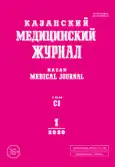Порядковая шкала рентгенологической оценки венозного застоя при хронической сердечной недостаточности
- Авторы: Колядич М.И.1
-
Учреждения:
- Южно-Уральский государственный медицинский университет
- Выпуск: Том 101, № 1 (2020)
- Страницы: 112-118
- Тип: Обмен клиническим опытом
- URL: https://ogarev-online.ru/kazanmedj/article/view/20394
- DOI: https://doi.org/10.17816/KMJ2020-112
- ID: 20394
Цитировать
Аннотация
Цель. Разработать порядковую шкалу рентгенологической оценки венозного застоя при хронической сердечной недостаточности по результатам стандартной оценки обзорных рентгенограмм грудной клетки.
Методы. Порядковая оценка по шкале складывается из числового выражения четырёх рентгенологических симптомов: кардиомегалии, наличия выпота в плевральных полостях, а также изменения лёгочного рисунка за счёт сосудистого и интерстициального компонентов. Наличие каждого из перечисленных симптомов соответствует оценке 1 балл. Общий показатель шкалы изменяется в диапазоне от 0 до 4 баллов. Одновременно с изучением показателя венозного застоя по шкале рентгенологической оценки у больных регистрируются объективные клинические, инструментальные и лабораторные показателя тяжести застойной сердечной недостаточности.
Результаты. Шкала рентгенологической оценки венозного застоя представлена числовыми оценками выраженности кардиомегалии, наличия выпота в плевральных полостях и изменения лёгочного рисунка за счёт сосудистого и интерстициального компонентов по данным стандартной оценки обзорных рентгенограмм грудной клетки. На выборке в 225 пациентов с хронической сердечной недостаточностью продемонстрирована критериальная валидность шкалы путём корреляционного сопоставления её числовых оценок с объективными клиническими, инструментальными и лабораторными показателями венозного застоя. Доказано статистически значимое прямое соответствие порядковых оценок шкалы показателям функционального класса и стадии хронической сердечной недостаточности, уровню NT-концевого фрагмента мозгового натрийуретического пептида, частоте дыхательных движений, оценке по шкале клинического состояния, индексу левого предсердия, систолическому давлению в лёгочной артерии, а также установлена обратная зависимость шкалы от показателей теста 6-минутной ходьбы. Продемонстрирована достаточная внутренняя согласованность шкалы рентгенологической оценки венозного застоя (α Кронбаха 0,73). Помимо критериальной валидности, шкала продемонстрировала предикторную информативность, проявившуюся существенным увеличением смертности пациентов с хронической сердечной недостаточностью при нарастании показателя шкалы до уровня ≥2.
Вывод. Предлагаемая шкала рентгенологической оценки венозного застоя обладает достаточной для практического применения надёжностью (внутренней согласованностью), а также критериальной и прогностической валидностью; шкалу можно рассматривать как простое, доступное и информативное дополнение к стандартному обследованию полиморбидных пациентов с хронической сердечной недостаточностью, что может оказаться полезным для углублённой оценки состояния пациента и риска его гибели в пределах ближайшего года.
Полный текст
Открыть статью на сайте журналаОб авторах
Мария Ильинична Колядич
Южно-Уральский государственный медицинский университет
Автор, ответственный за переписку.
Email: volchegorsky@gmail.com
Россия, г. Челябинск, Россия
Список литературы
- Мареев В.Ю., Фомин И.В., Агеев Ф.Т. и др. Клинические рекомендации ОССН — РКО — РНМОТ. Сердечная недостаточность: хроническая (ХСН) и острая декомпенсированная (ОДСН). Диагностика, профилактика и лечение. Кардиология. 2018; 58 (6): 10–164. doi: 10.18087/cardio.2475.
- Russell S.D., Saval M.A., Robbins J.L. et al. New York Heart Association functional class predicts exercise parameters in the current era. Am. Heart J. 2009; 158: 24–30. doi: 10.1016/j.ahj.2009.07.017.
- Беленков Ю.Н., Агеев Ф.Т. Эпидемиология и прогноз хронической сердечной недостаточности. Русский мед. ж. 1999; (2): 1–2.
- Тюрин И.Е. Рентгенодиагностика отёков лёгких. Практическая пульмонология. 2005; (2): 18–22.
- Kobayashi M., Watanabe M., Coiro S., et al. Mid-term prognostic impact of residual pulmonary congestion assessed by radiographic scoring in patients admitted for worsening heart failure. Intern. J. Cardiol. 2019; 289: 91–98. doi: 10.1016/j.ijcard.2019.01.091.
- Линденбратен Л.Д., Наумов Л.Б. Медицинская рентгенология. М.: Медицина. 1984; 384 с.
- Розенштраух Л.С., Рыбакова Н.И., Виннер М.Г. Рентгенодиагностика заболеваний органов дыхания. М.: Медицина. 1987; 640 с.
- World Medical Association Declaration of Helsinki. Ethical Principles for Medical Research Involving Human Subjects. JAMA. 2013; 310 (20): 2191–2194. doi: 10.1001/jama.2013.281053.
- Беленков Ю.Н., Мареев В.Ю. Принципы рационального лечения хронической сердечной недостаточности. М.: Медиа Медика. 2000; 266 с.
- Рекомендации по количественной оценке структуры и функции камер сердца. Рос. кардиол. ж. 2012; (3): 1–28.
Дополнительные файлы









